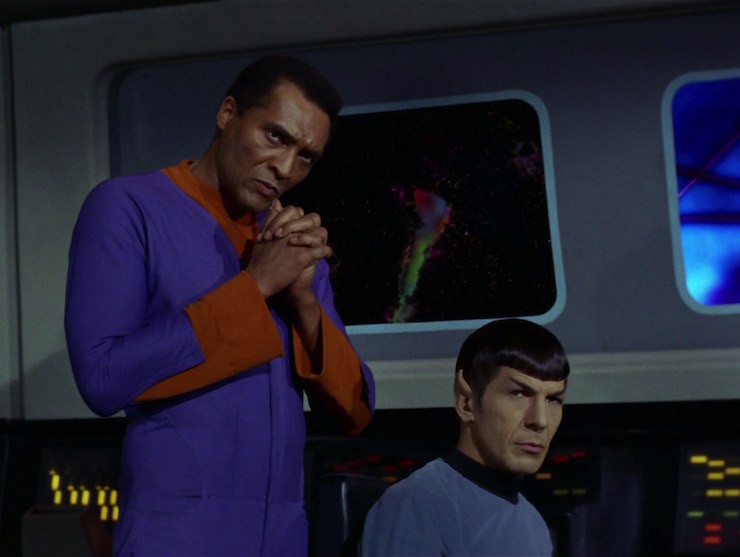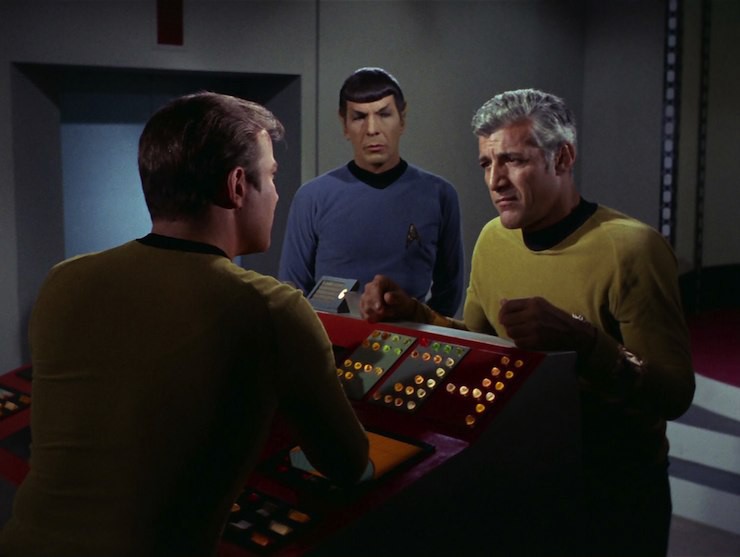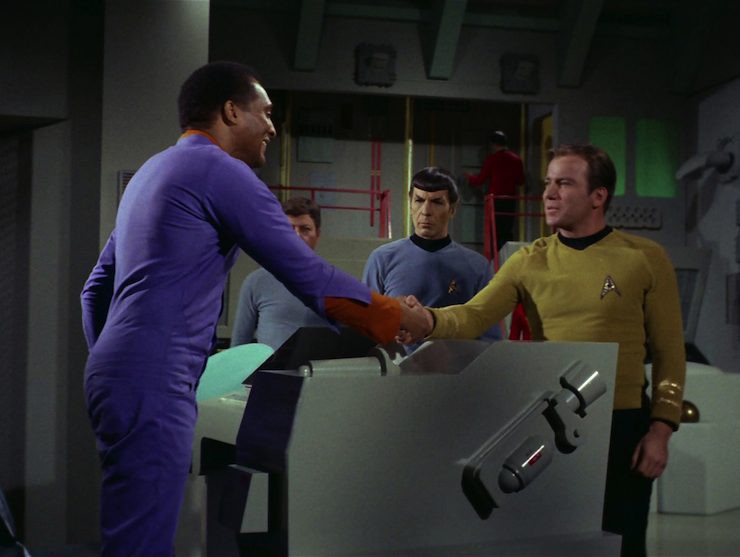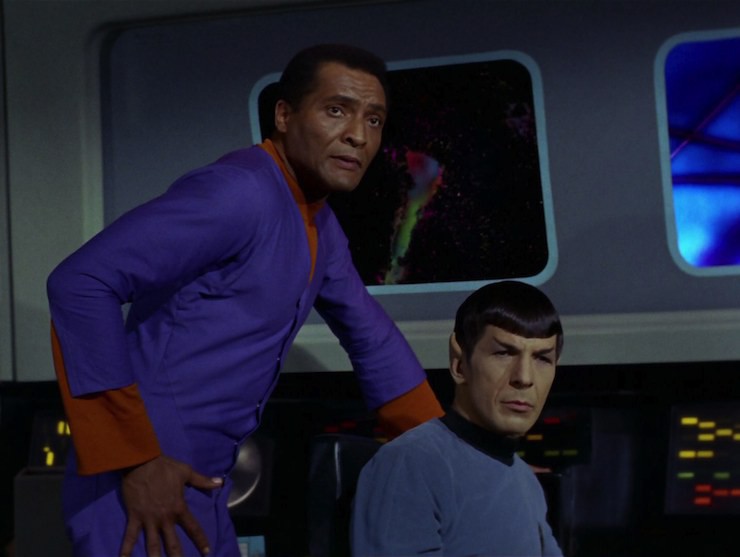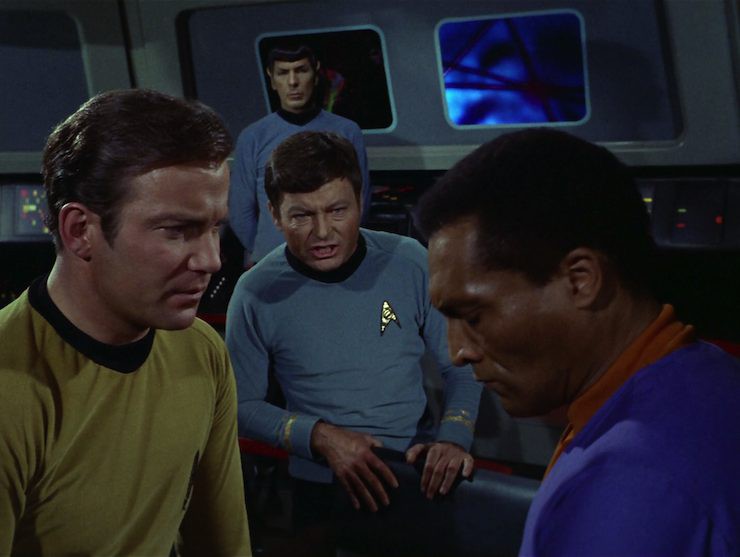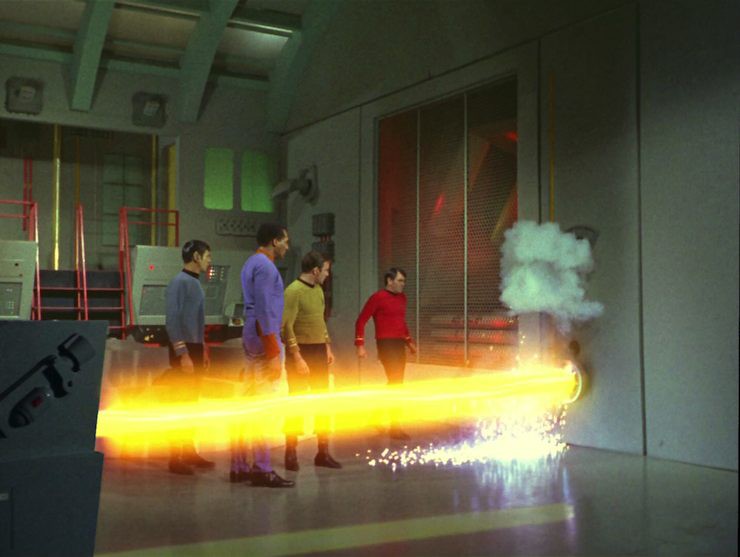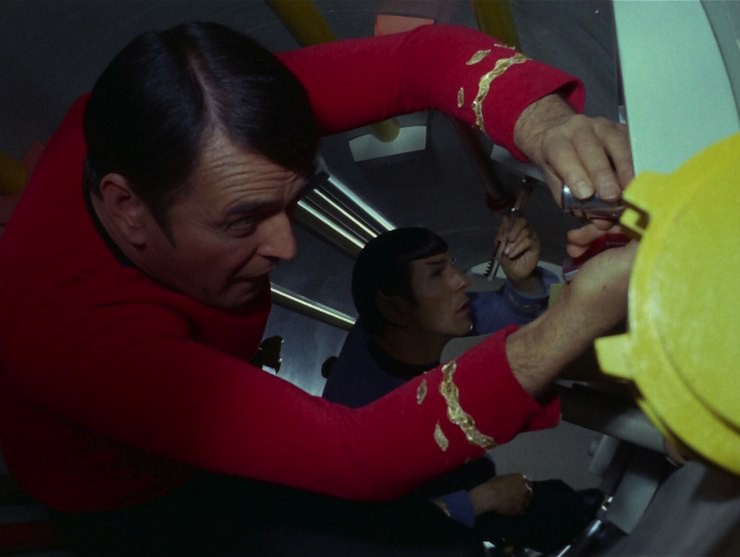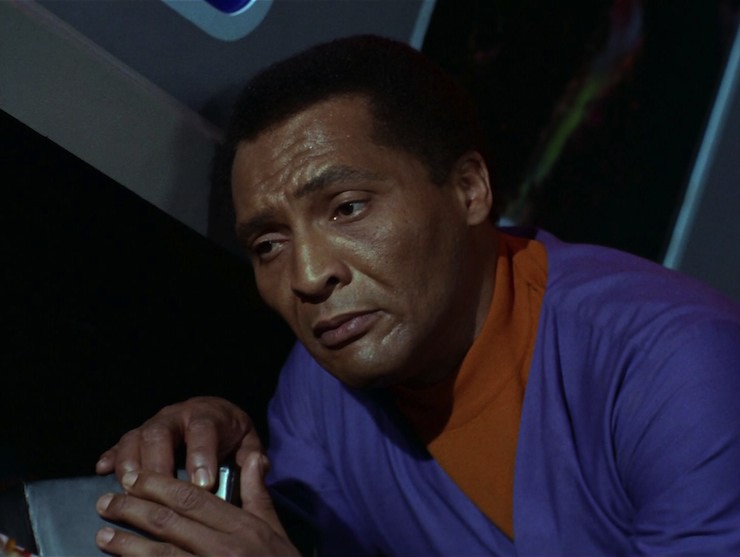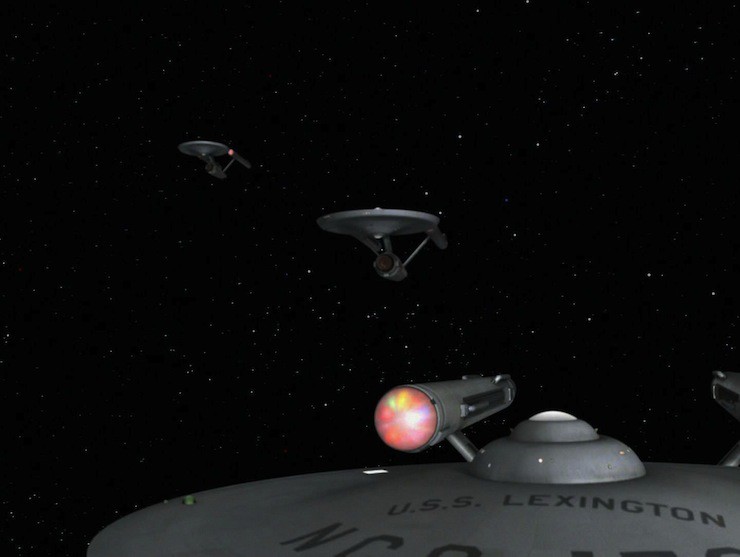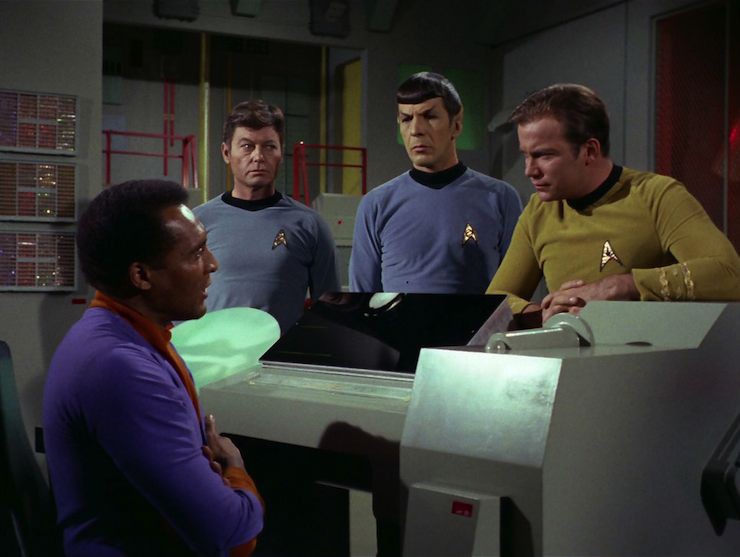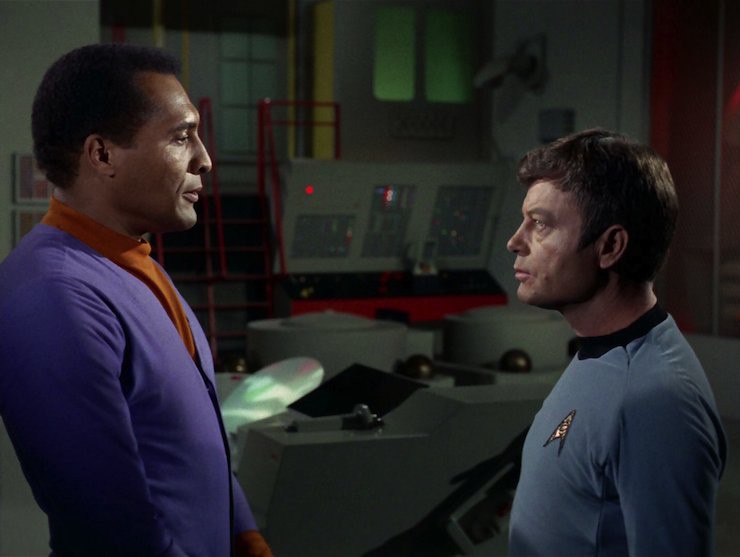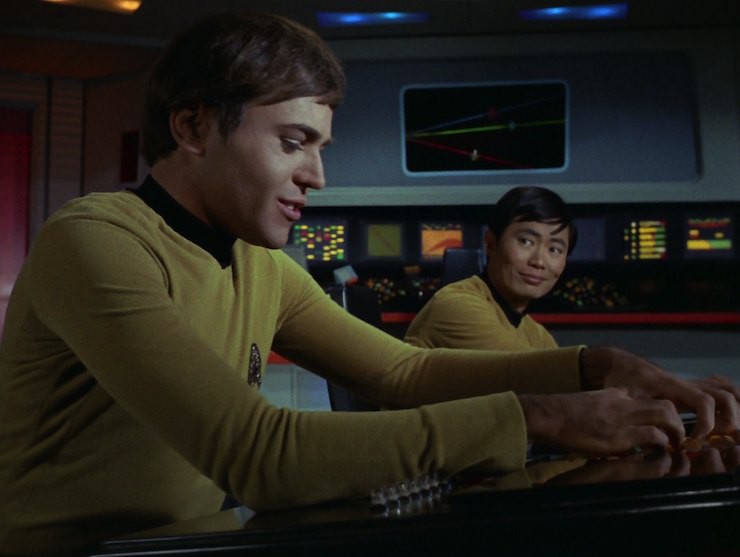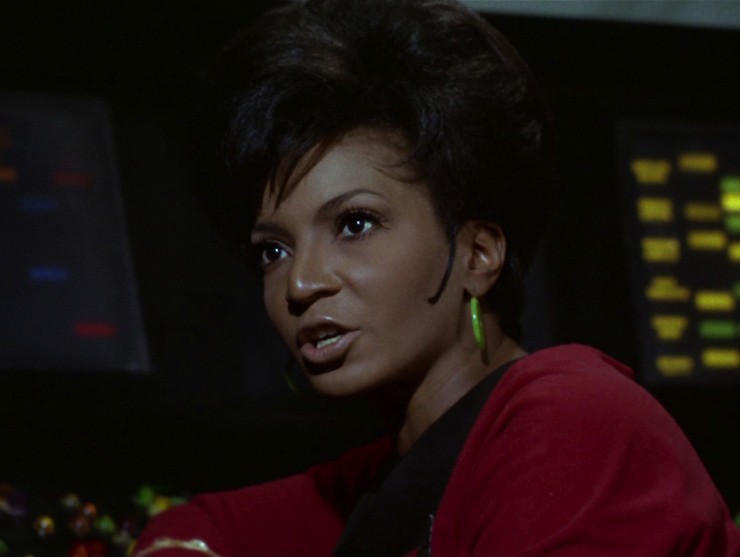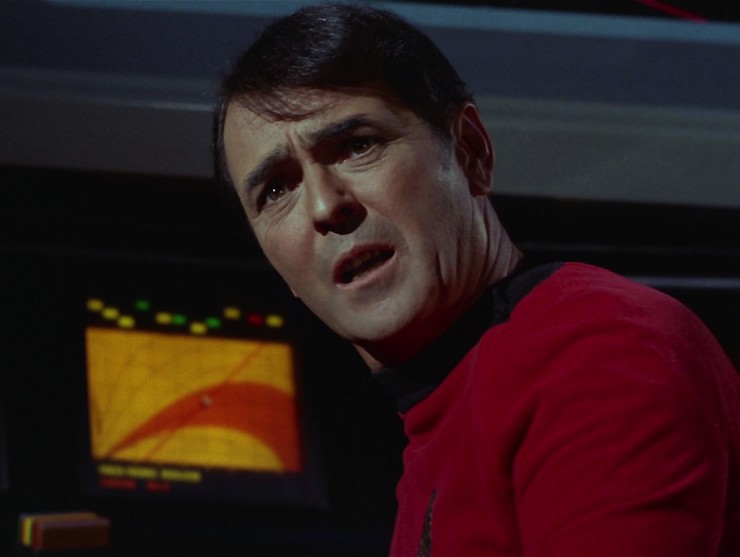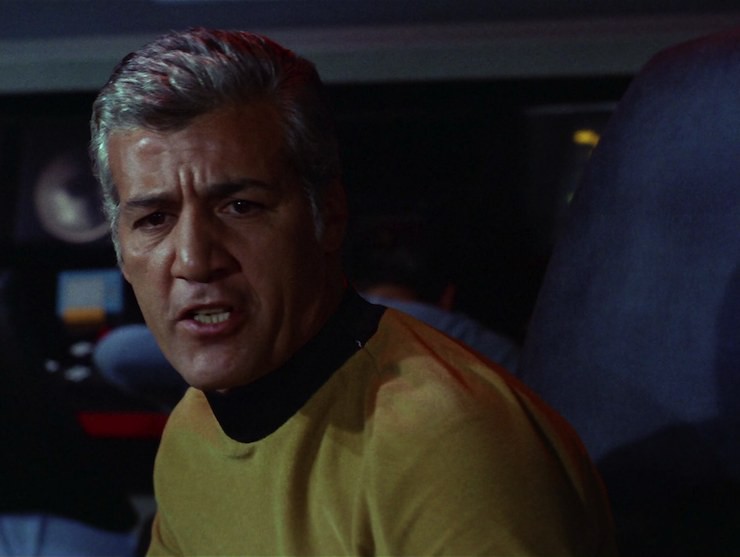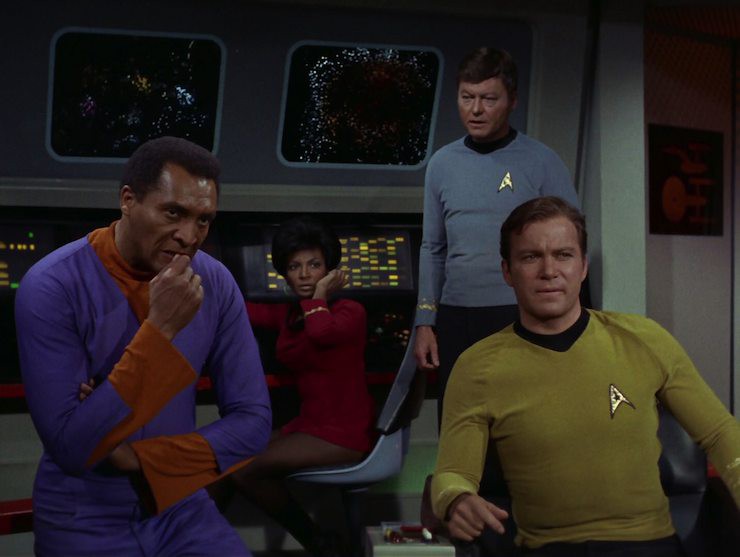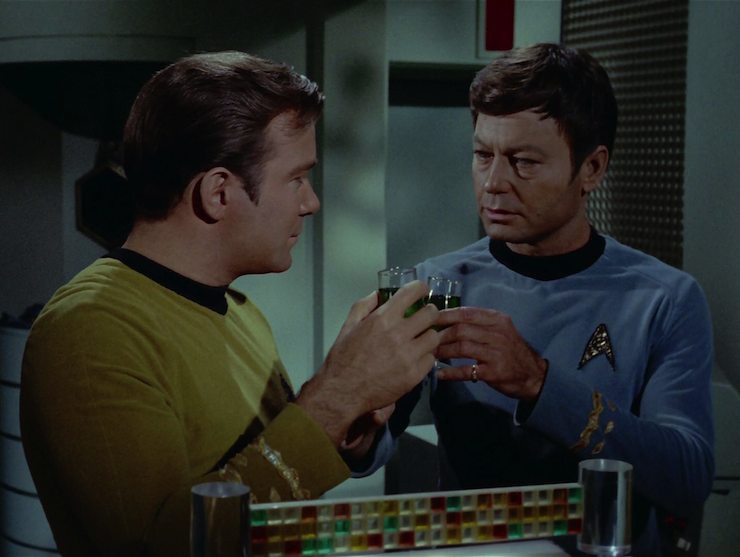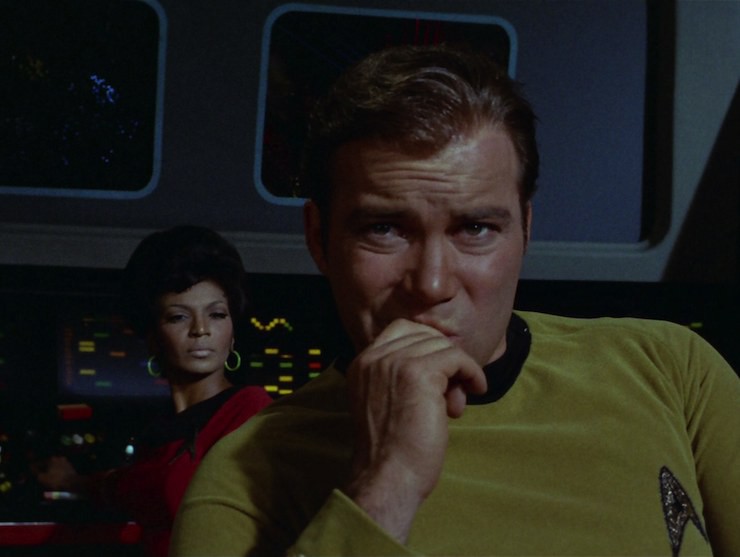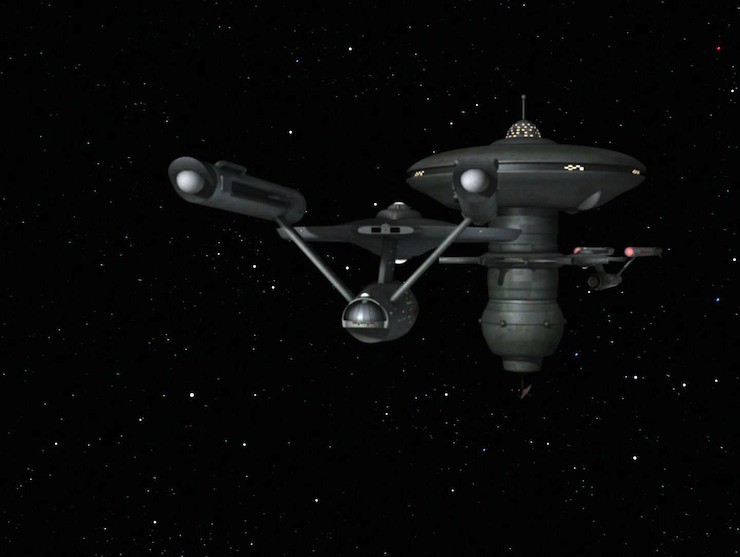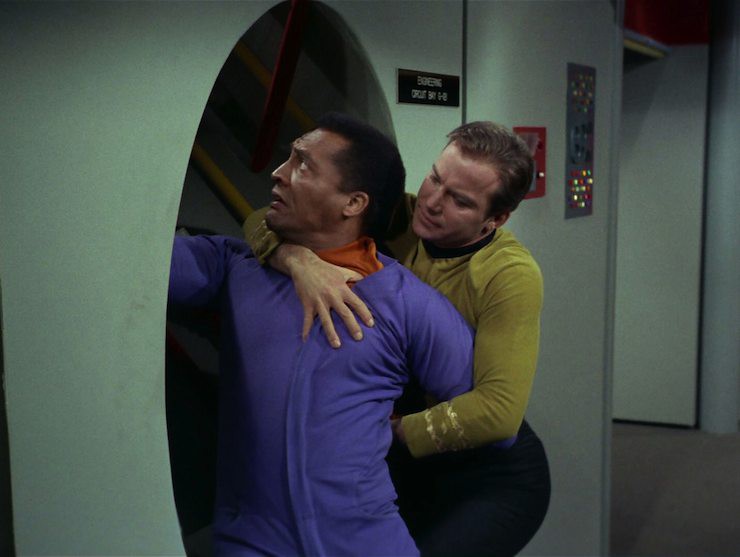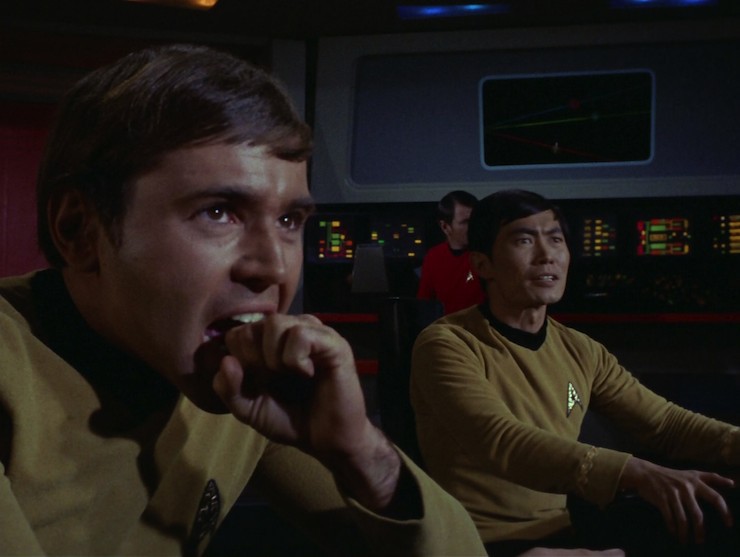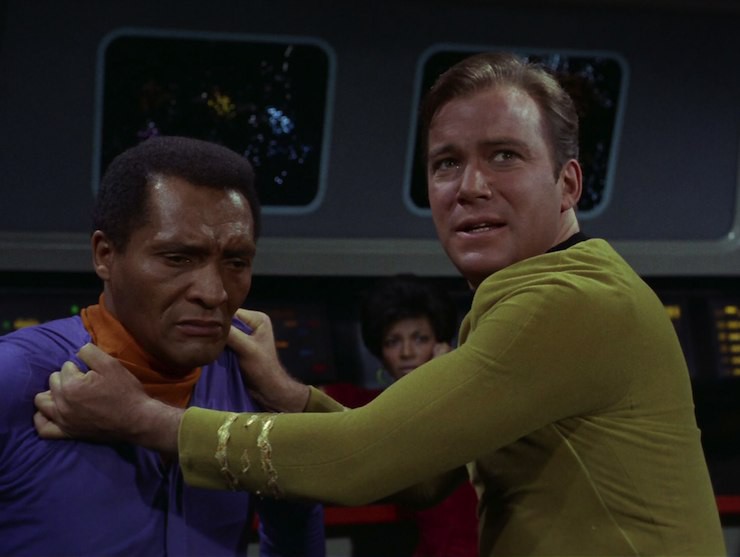“The Ultimate Computer”
Written by Laurence N. Wolfe and D.C. Fontana
Directed by John Meredyth Lucas
Season 2, Episode 24
Production episode 60353
Original air date: March 8, 1968
Stardate: 4729.4
Captain’s log. The Enterprise has been summoned to Starbase 6 for an experiment. Dr. Richard Daystrom—who designed the duotronic computer systems used on the Enterprise—has developed the M-5 multitronic computer system. The M-5 will be installed on the Enterprise and tested. It will require only a crew of twenty—Kirk himself just has to sit back and let the machine do all the work.
Part of the experiment involves war games—the M-5 controlled Enterprise versus a fleet of ships led by Commodore Bob Wesley and the Lexington. It’s Wesley who gives Kirk his orders.
Daystrom hooks the M-5 up in engineering. On Kirk’s order, Scotty hooks the computer into the ship’s main power. There’s a hiccup, but Daystrom fixes it, refusing Spock’s assistance. Kirk is apprehensive—McCoy points out that it’s natural to be fine with mechanization taking away jobs until it’s your job, but he also points out that if Kirk has to ask if he’s afraid, he probably isn’t.
The Enterprise performs some simple maneuvers, then approach a planet. M-5 puts the ship into orbit and makes recommendations as to who should go on the landing party–Kirk insists on the latter himself. The captain recommends a survey party that avoids the natives and includes Kirk, Spock, McCoy, an astrobiologist, and a geologist. M-5 has its own recommendations: Spock, the astrobiologist, and a different, lower-ranking, geologist due to his experience on a merchant vessel in the sector. M-5 also deems Kirk and McCoy to be nonessential personnel.
M-5 shuts down power on several decks. Daystrom says it has done so because those sections are unoccupied. Spock also notices that the M-5 is drawing more power from those shut-down decks.
Uhura reports two contacts: it’s the Excalibur and the Lexington, here for an unscheduled battle drill. M-5 responds to Wesley’s hail before Uhura can and also goes to red alert before Kirk can sound it. M-5 runs the whole battle itself, leaving Sulu and Chekov to just narrate it as the Enterprise does very well—its response times were far faster than any human could have reacted.
Wesley sends his congratulations to the M-5 unit and his regards to “Captain Dunsel.” Kirk just walks off the bridge, leaving a confused McCoy to ask who the hell Captain Dunsel is. Spock has to explain that “dunsel” is a term used by students at Starfleet Academy to refer to a part that serves no useful purpose.
McCoy brings Kirk a drink to his quarters, and the captain waxes poetic about sailing ships and feeling useless and other fun stuff. He’s interrupted by contact with another ship—it’s not a drill, it’s the Woden, an automated ore freighter.
The deflectors come on and the M-5 brings the Enterprise toward the Woden. Kirk disengages M-5—but it doesn’t take. Sulu can’t fly the ship, Scotty can’t engage manual override. M-5 heads to the Woden, locks photon torpedoes, and destroys it.
McCoy is livid at the wanton destruction, and Daystrom is confused. Kirk wants M-5 disengaged immediately and the tests finished before M-5 actually kills someone. Since they can’t turn the computer off from the console on the bridge, they go to engineering to turn it off at the source. However, M-5 has put a force field around itself so they can’t approach the unit, and when Ensign Harper tries to disengage it from the engines, M-5 fires a laser that vaporizes Harper and also allows it to draw power directly from the warp engine.
Daystrom insists to McCoy that M-5 is growing and learning. McCoy points out that it’s learning to kill, but Daystrom insists it’s just defending itself. (How it needed defending from a robot ore freighter and an ensign is left unclear.) He also insists that M-5 can keep people from dying needlessly in space, which will be small comfort to Harper’s family.
McCoy digs into Daystrom’s psychological history. He won the Nobel and Zee-Magnes Prizes at the age of twenty-four for the development of duotronics. McCoy hypothesizes that Daystrom peaked early and is trying desperately to recapture past glory. The M-1 through M-4 were all unsuccessful (presumably they all fell into the swamp…), and McCoy wonders if the M-5 is just as unsuccessful.
Spock and Scotty try to bypass the primary circuits to helm and navigation, but M-5 rerouted as soon as they started, and so it fails. M-5 still controls the ship.
Daystrom finally explains his “new approach” to computer science with multitronics: he’s imprinted human engrams upon the M-5, allowing it to think like a person.
Uhura reports that the Lexington, Excalibur, Hood, and Potemkin are approaching for the war game. M-5 charges phasers at full power and fires on the Lexington. The war games deteriorate pretty quickly, with hundreds of dead. Wesley contacts Starfleet Command asking permission to destroy the Enterprise.
Daystrom reveals that M-5 was imprinted with his own engrams. Spock hypothesizes that perhaps Daystrom can talk to it. Daystrom agrees, and he tells M-5 that it’s committing murder. It was created to save people, not murder them. Unfortunately, Daystrom has gone completely binky-bonkers, cluck-cluck, gibber gibber, my old man’s a mushroom, etc., embittered and miserable because he’s invented nothing new since his twenties. Spock neck pinches him before he can complete his epic tirade about how nothing will stop him or M-5.
Uhura reports that Wesley has been authorized to use lethal force on the Enterprise. Kirk tries talking to M-5 (hey, he’s done it before…). M-5 says it must survive to protect humanity—basically the same speech that Daystrom gave earlier about preserving lives. Kirk points out that it’s committed murder. M-5 says it can’t have committed murder, so Kirk tells it to scan the Excalibur, which has been crippled, all hands lost. Realizing it has committed murder, M-5 shuts completely down, lowering shields. Spock figures it’s guilty and is committing suicide by leaving itself open to attack by the other three ships.
Scotty and Spock unplug M-5 from the ship, but Scotty can’t get communications back online for a bit, so Kirk orders all power shut down, gambling that Wesley wouldn’t fire on a defenseless ship. Sure enough, the commodore breaks off the attack.
McCoy says that Daystrom will have to be committed to rehab.
Can’t we just reverse the polarity? Daystrom has found a way to make computers think like humans: imprinting a human’s memory engrams onto the computer’s operating system. While the phrase “artificial intelligence” isn’t used—the term had only been in use for a decade when this episode was produced—that’s basically what it is. Unfortunately, using the engrams of a guy on the verge of a psychotic break probably wasn’t the best plan.
Fascinating. Spock has an A-7 computer rating, which presumably makes him an ace.
I’m a doctor not an escalator. McCoy is skeptical about the M-5 from jump, and his rant at Daystrom after the Woden is destroyed is epic. “It just destroyed an ore freighter! In fact, it went out of its way to destroy an ore freighter!” But he’s also the one who diagnoses Daystrom’s psychological issues.
Ahead warp one, aye. Sulu is left to spectate as the M-5 does his job.
It’s a Russian invention. Chekov is likewise left to spectate. He and Sulu get a moment of joy when they think they have control back, which is the only real moment the two of them have. Otherwise, they’re just reading off a litany of what M-5 is doing.
I cannot change the laws of physics! Scotty is not happy about the M-5 being hooked up to the engines—he refuses to do so until he gets a specific order from Kirk to do so.
Hailing frequencies open. Uhura’s the only person who can still do things when M-5 takes over, as she can still pick up and route communications.
Go put on a red shirt. Poor Ensign Harper has the bad luck of trying to disconnect M-5 right when it decides to increase power with a big-ass laser. His death changes the tenor of the episode, as M-5 was a nuisance up to that point—once it commits murder, all bets are off.
Channel open. “It would be most interesting to impress your memory engrams on a computer, Doctor. The resulting torrential flood of illogic would be most entertaining.”
Spock, taking the piss out of McCoy.
Welcome aboard. Barry Russo, having previously played Giotto in “The Devil in the Dark,” plays Wesley. Sean Morgan, having previously played O’Neil in “The Return of the Archons” (and who will play that role again in “The Tholian Web”), plays Harper. James Doohan does triple duty, not only as Scotty, but also as the voices of both M-5 and of one of the other commodores, and he’s joined by other recurring regulars George Takei, Nichelle Nichols, and Walter Koenig.
But the big guest is Blacula himself, the great William Marshall, who lends his amazing voice and powerful presence to the role of Daystrom.
Trivial matters: Having written two episodes, show-runner John Meredyth Lucas takes a hand at directing this time ’round, making him the first person in Trek history to both write and direct an episode.
Kirk quotes the famous line from John Masefield’s Sea Fever, “And all I ask is a tall ship and a star to steer her by.” Kirk will quote it again in Star Trek V: The Final Frontier, Quark will paraphrase it in DS9‘s “Little Green Men,” and that quote will be on the dedication plaque for the Defiant in the latter show.
Wesley will appear again in the animated episode “One of Our Planets is Missing,” voiced by James Doohan, and the character also appears in multiple works of tie-in fiction, among them the novels Burning Dreams by Margaret Wander Bonanno, Yesterday’s Son by A.C. Crispin, Allegiance in Exile by David R. George III, Section 31: Cloak by S.D. Perry, and The Disinherited by Peter David, Michael Jan Friedman, & Robert Greenberger (a novel that also features the character of Giotto, also played by Barry Russo, with Wesley making a comment that he likes the cut of Giotto’s jib), and the novellas Where Time Stands Still (part of the Starfleet Corps of Engineers series) and The First Peer (in Seven Deadly Sins) both by Dayton Ward & Kevin Dilmore.
Daystrom will be seen again in the novel The Rift by Peter David. The TNG episode “The Measure of a Man” will establish the Daystrom Institute, a Federation scientific facility named after the character, which will be mentioned in numerous episodes of TNG, DS9, and Voyager.
The Lexington will be mentioned again in DS9‘s “Trials and Tribble-ations.” The Potemkin will be mentioned again in “Turnabout Intruder,” the animated episode “The Pirates of Orion,” and Star Trek VI: The Undiscovered Country.
The remastering of this episode had a nice nod to the tie-in novels. In 2005, Simon & Schuster debuted a novels-only series that took place concurrently with the original series entitled Vanguard. It took place on Starbase 47, a Watchtower-class starbase that was designed especially for the novels series by Masao Okazaki. In the remastered version of this episode, Starbase 6 (which was a reuse of the Deep Station K-7 model from “The Trouble with Tribbles” in the original broadcast) was replaced by a computer-generated Watchtower-class starbase. Reports that Vanguard co-creator/editor (and current Tor Books editor) Marco Palmieri squealed like a small child when the remastered episode aired are unconfirmed. (Oh, who am I kidding? They’re totally confirmed…)
To boldly go. “You can’t simply say, ‘Today I will be brilliant!'” My formative years experiencing Star Trek were twofold. The first was obvious: the reruns on WPIX Channel 11 here in New York City, which was my initial exposure to the show. But the other, and ultimately at least as important, were the adaptations by James Blish (assisted in the end by his widow J.A. Lawrence).
For whatever reason—the vicissitudes of scheduling, both my own and that of WPIX—I didn’t see “The Ultimate Computer” for a long time on television, to the point that I had very little memory of the episode. All I had was Blish’s adaptation in Star Trek 9.
So when I read the adaptation (which I did a lot with the Blish books—those spines are seriously cracked…), my brain filled in Daystrom as a white guy.
And then I finally did catch the episode when I was, I dunno, eleven or twelve or so, and was gobsmacked by the casting of William Marshall—and not just because I was a fan of Blacula.
That was a major formative experience for me, as I realized that I was letting my prejudices shine through. I’ve always made a conscious effort to not default to the white guy every time, and one of the reasons why is because I was wrong about Daystrom for so long.
But that’s only one of the reasons why the casting of Marshall was brilliant. He is simply overpowering: his echo-y voice, his immense height, his commanding presence, all combine to create a character you’re forced to pay attention to. More impressively is that, despite all the opportunities to do so, he doesn’t overplay it. He comes close a few times (like the exaggerated “urk!” expression he puts on when Spock neck pinches him), but he especially plays up the bitterness of the expectations that have been unfairly placed on him.
The moral here is a very simplistic one: machines can’t replace people. Well, that and be careful not to peak in your twenties. The 1960s was when people were genuinely starting to fear that automation would replace people’s jobs, and that’s still a concern five decades later. (As just one example, there are a lot fewer people whose job it is to take your toll in a toll booth than there were twenty years ago.) Star Trek will go down this well again, when we get true AIs in Data and the EMH, but this first look at it is an interesting one. The real compelling story here, though, isn’t really M-5, but Daystrom. This is someone who revolutionized the computing world twenty years earlier and has spent the two decades since living in the shadow of his younger self. Marshall beautifully plays the desperation, the eagerness to prove that he hasn’t blown his wad, that he still can be useful.
Warp factor rating: 8
Next week: “The Omega Glory”
Keith R.A. DeCandido loves rock and roll, so put another dime in the jukebox, baby.










